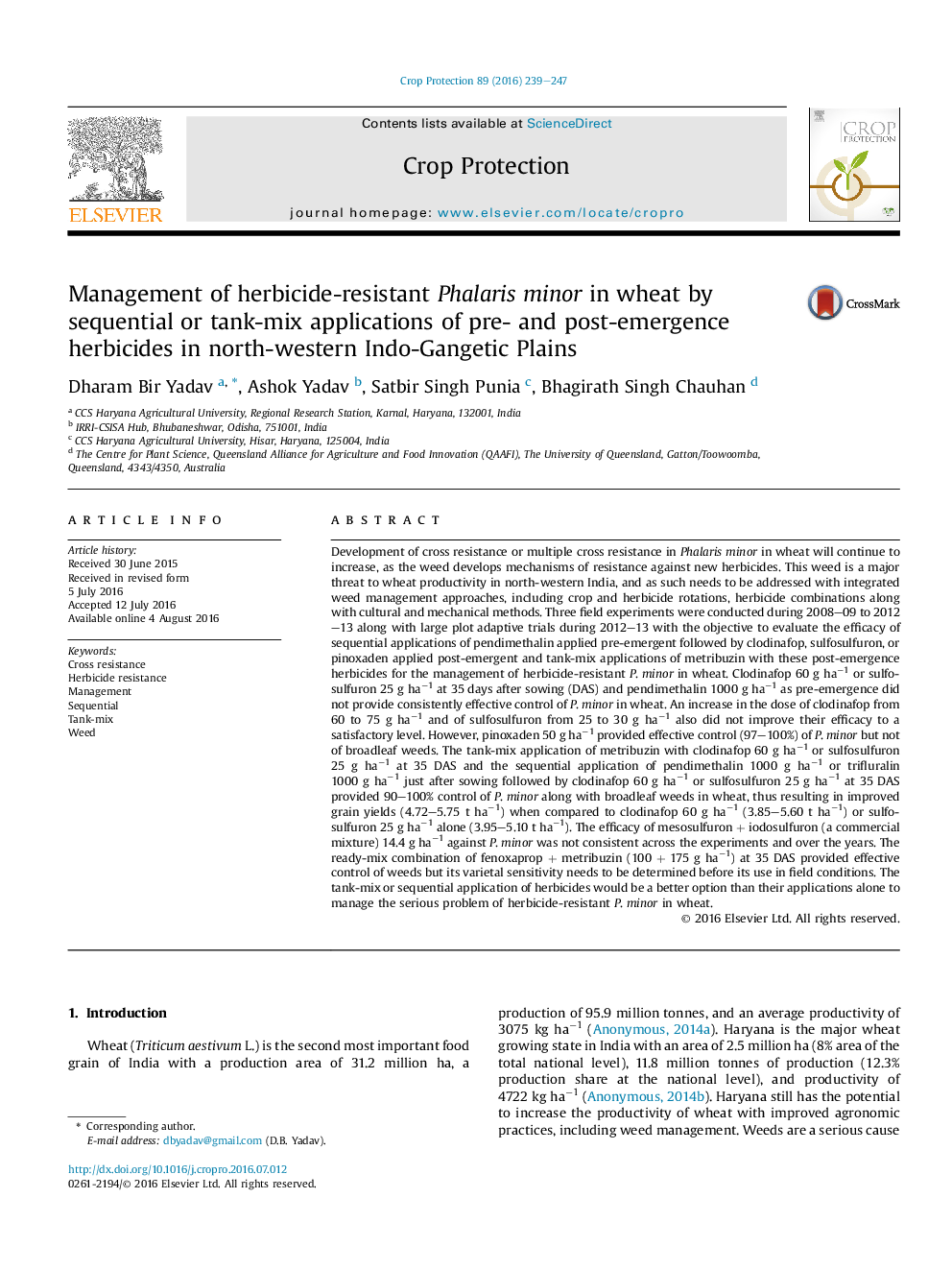| کد مقاله | کد نشریه | سال انتشار | مقاله انگلیسی | نسخه تمام متن |
|---|---|---|---|---|
| 6373190 | 1624298 | 2016 | 9 صفحه PDF | دانلود رایگان |

- Phalaris minor is a serious weed in India due to multiple herbicide resistance.
- Clodinafop and sulfosulfuron as POST have reduced efficacy against P. minor.
- Sequential spray of these herbicides after pendimethalin effectively managed it.
- Tank-mix of clodinafop or sulfosulfuron with metribuzin proved effective against it.
- Pinoxaden alone as POST was also effective against P. minor.
Development of cross resistance or multiple cross resistance in Phalaris minor in wheat will continue to increase, as the weed develops mechanisms of resistance against new herbicides. This weed is a major threat to wheat productivity in north-western India, and as such needs to be addressed with integrated weed management approaches, including crop and herbicide rotations, herbicide combinations along with cultural and mechanical methods. Three field experiments were conducted during 2008-09 to 2012-13 along with large plot adaptive trials during 2012-13 with the objective to evaluate the efficacy of sequential applications of pendimethalin applied pre-emergent followed by clodinafop, sulfosulfuron, or pinoxaden applied post-emergent and tank-mix applications of metribuzin with these post-emergence herbicides for the management of herbicide-resistant P. minor in wheat. Clodinafop 60 g haâ1 or sulfosulfuron 25 g haâ1 at 35 days after sowing (DAS) and pendimethalin 1000 g haâ1 as pre-emergence did not provide consistently effective control of P. minor in wheat. An increase in the dose of clodinafop from 60 to 75 g haâ1 and of sulfosulfuron from 25 to 30 g haâ1 also did not improve their efficacy to a satisfactory level. However, pinoxaden 50 g haâ1 provided effective control (97-100%) of P. minor but not of broadleaf weeds. The tank-mix application of metribuzin with clodinafop 60 g haâ1 or sulfosulfuron 25 g haâ1 at 35 DAS and the sequential application of pendimethalin 1000 g haâ1 or trifluralin 1000 g haâ1 just after sowing followed by clodinafop 60 g haâ1 or sulfosulfuron 25 g haâ1 at 35 DAS provided 90-100% control of P. minor along with broadleaf weeds in wheat, thus resulting in improved grain yields (4.72-5.75 t haâ1) when compared to clodinafop 60 g haâ1 (3.85-5.60 t haâ1) or sulfosulfuron 25 g haâ1 alone (3.95-5.10 t haâ1). The efficacy of mesosulfuron + iodosulfuron (a commercial mixture) 14.4 g haâ1 against P. minor was not consistent across the experiments and over the years. The ready-mix combination of fenoxaprop + metribuzin (100 + 175 g haâ1) at 35 DAS provided effective control of weeds but its varietal sensitivity needs to be determined before its use in field conditions. The tank-mix or sequential application of herbicides would be a better option than their applications alone to manage the serious problem of herbicide-resistant P. minor in wheat.
Journal: Crop Protection - Volume 89, November 2016, Pages 239-247